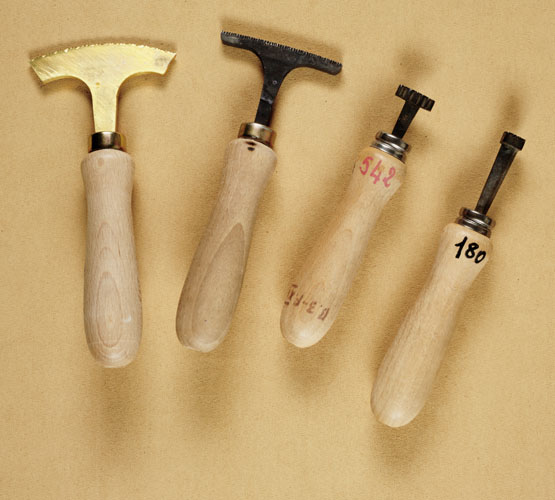THE TOOLS AND TECHNIQUES OF DECORATIVE BOOKBINDING

Early leather decoration was made with small wooden or ivory stamps, which were gradually replaced by alloy instruments, mostly bronze or brass tools provided with wooden handles of varying lengths. The arrival of metal led to a new technique of impression, known as blind tooling, whereby leather no longer needed dampening in order to be impressed. As early as the 15th century, the tools, which might vary in size, bore an ample choice of decorative patterns borrowed both from the natural world and the realms of fantasy. Decorative patterns alternated with sacred inscriptions. Blind tooling involved the use of heated tools. Meticulous care was needed for heating the tools. As a matter of fact, excessive heating might have burnt the leather, while insufficiently heated tools might not have ensured a clear, distinct impression.
A panel stamp is a small finishing tool originally made of hardwood, engraved intaglio, bearing simple patterns like crosses, quatrefoils and rosettes.
The roll came into use alongside the stamp. Nordic in origin, it consisted of a metal cylinder of variable thickness, the circumference of which was engraved intaglio or in relief with thin fillets or decorative patterns. Once heated and run over the leather, it was used in order to make repeating strip patterns all along the border, and much more quickly than with the small tools, which had to be impressed one by one. Like other finishing tools, the roll was provided with a long wooden handle, which enabled a craftsman to exert all the pressure required to impress leather or parchment by holding the instrument with his shoulder. Like medieval seals, the rolls for blind tooling were cut intaglio so as to impress leather with a pattern in relief standing out from the surface. Decoration with goldleaf, instead, involved using rolls having a design in relief, so as to impress leather very deeply. Narrow at the start, rolls grew larger over time - which called for increasingly skilled craftsmen.
The blocking press was a finishing tool in use in Flanders since the 13th century. Operated through a screw press, it was cut in iron or bronze, and bore patterns intaglio or in relief. Set in a wooden or metal framework, the blocking press ensured that the cover of an octavo or a twelvemo volume was rapidly decorated in its entirety, or, as was the case with quartos and folios, it was used to impress about three quarters of a cover. A press could be engraved and cut to almost any shape, representing a wide range of themes, with a predominance of scenes from the Old and New Testament (No 16), portraits of saints - especially in France and the Netherlands -, and in 16th-century Germany notables of the Reformation (No 103.)
In the second half of the 15th century, all such tools turned out to be perfectly suitable for gilding. If, in the early days of gilding, gold was used in liquid or powder form, as time went by it was beaten into very thin sheets of variable purity, known as gold leaf.


